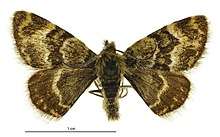Notoreas blax
Notoreas blax is a species of moth in the family Geometridae. This species is endemic to New Zealand. This moth frequents alpine habitat and can be found in the Canterbury and Otago regions.
| Notoreas blax | |
|---|---|
 | |
| Female | |
 | |
| Male | |
| Scientific classification | |
| Kingdom: | Animalia |
| Phylum: | Arthropoda |
| Class: | Insecta |
| Order: | Lepidoptera |
| Family: | Geometridae |
| Genus: | Notoreas |
| Species: | N. blax |
| Binomial name | |
| Notoreas blax | |
Taxonomy
This species was described by Louis Beethoven Prout in 1939 using material collected by George Howes at Bold Peak, Humboldt Range.[2][1] In 1986 R. C. Craw reviewed the genus Notoreas and confirmed the inclusion of N. blax within it.[3] The holotype specimen of this species is held at the Natural History Museum, London.[1]
Description
This species has a wingspan of between 20 – 22 mm and is similar in appearance to N. atmogramma.[2] However it is paler on the upper side of its wings and is slightly less brown than a typical N. atmogramma.[2]
Distribution
This species is endemic to New Zealand.[4][5] It is found in West Otago localities in the high alpine zone of mountain ranges.[6] It has also been found in Aoraki / Mount Cook National Park also in the high alpine zone of that park.[7]
Biology and behaviour
This species is a day flying moth.[6] It is on the wing in February.[2] Adult moths, when settled, continue to vibrate their wings ensuring they are immediately ready to take off should they be disturbed.[8] Although they prefer sunshine they will continue to fly when conditions are cloudy.[8] They fly relatively low to the ground.[8] When resting for long periods they adopt the posture of holding their wings together above their body.[8]
Habitat and host species
This species frequents alpine habitat.[6] The larvae of this species feed on dwarf shrubs of Kelleria species including Kelleria croizatii.[6][7]
References
| Wikimedia Commons has media related to Notoreas blax. |
- Dugdale, J. S. (1988). "Lepidoptera - annotated catalogue, and keys to family-group taxa" (PDF). Fauna of New Zealand. 14: 184. Retrieved 15 June 2018.
- Prout, L. B. (1939). "Geometridae: Fauna Indo-Australica". The Macrolepidoptera of the World (Stuttgart). 12: 237–292 – via Biodiversity Heritage Library.
- Craw, R.C. (5 January 2012). "Review of the genus Notoreas (Lepidoptera: Geometridae: Larentiinae)". New Zealand Journal of Zoology. 13 (1): 131–140. doi:10.1080/03014223.1986.10422654.
- "Notoreas blax Prout, 1939". www.nzor.org.nz. Landcare Research New Zealand Ltd. Retrieved 2018-06-16.
- Gordon, Dennis P., ed. (2010). New Zealand Inventory of Biodiversity, Volume=Two, Kingdom Animalia: Chaetognatha, Ecdysozoa, Ichnofossils. Vol. 2. Christchurch, N.Z.: Canterbury University Press. p. 460. ISBN 9781877257933. OCLC 973607714.
- Mt Aspiring Station-Conservation Resources Report pt1 (PDF) (Report). Land Information New Zealand Ltd. November 2005. pp. 1–96. Retrieved 15 June 2018.
- Peat, Neville; Patrick, Brian (2001). Wild rivers : discovering the natural history of the Central South Island. Dunedin: University of Otago Press. p. 127. ISBN 9781877276156.
- Patrick, BH; Hoare, RJB; Rhode, BE (December 2010). "Taxonomy and conservation of allopatric moth populations: a revisionary study of the Notoreas perornata Walker complex (Lepidoptera: Geometridae: Larentiinae), with special reference to southern New Zealand". New Zealand Journal of Zoology. 37 (4): 257–283. doi:10.1080/03014223.2010.511127.